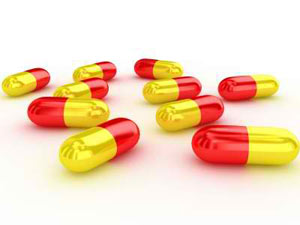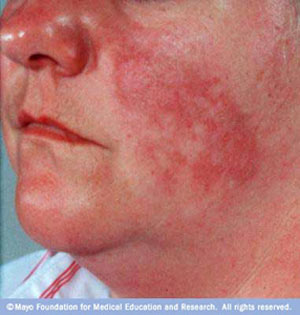سه شنبه, ۱ خرداد, ۱۴۰۳ / 21 May, 2024
Drug allergies

Definition
Drug allergies are a group of symptoms caused by allergic reaction to a drug.
Symptoms
Anaphylaxis, or severe allergic reaction (see below)
Hives (a less common type of rash)
Itching of the skin or eyes (common)
Skin rash (common)
Swelling of the lips, tongue, or face
Wheezing
Symptoms of anaphylaxis include:
Abdominal pain or cramping
Confusion
Diarrhea
Difficulty breathing with wheeze or hoarse voice
Dizziness
Fainting, light-headedness
Hives over different parts of the body
Nausea, vomiting
Rapid pulse
Sensation of feeling the heart beat (palpitations)
Causes & Risk Factors
Adverse reactions to drugs are common, and almost any drug can cause an adverse reaction. Reactions range from irritating or mild side effects such as nausea and vomiting to life-threatening anaphylaxis.
A true drug allergy results from a series of chemical steps within the body that produce the allergic reaction to a medication. One time (often the first time you take the drug), your immune system launches an incorrect response that is not noticeable. The next time you take the drug, an immune response occurs, and your body produces antibodies and histamine.
Most drug allergies cause minor skin rashes and hives. Serum sickness is a delayed type of drug allergy that occurs a week or more after exposure to a medication or vaccine.
Penicillin and related antibiotics are the most common cause of drug allergies. Other common allergy-causing drugs include:
Sulfa drugs
Anticonvulsants
Insulin preparations (particularly animal sources of insulin)
Iodinated (containing iodine) x-ray contrast dyes (these can cause allergy-like anaphylactoid reactions)
Most side effects of drugs are not due to an allergic reaction. For example, aspirin can cause nonallergic hives or trigger asthma. Some drug reactions are considered "idiosyncratic." This means the reaction is an unusual effect of the medication, not due to a predictable chemical effect of the drug. Many people confuse an uncomfortable, but not serious, side effect of a medicine (such as nausea) with a true drug allergy, which can be life threatening.
Tests & Diagnostics
An examination of the skin and face may show hives, rash, or angioedema (swelling of the lips, face, or tongue). Decreased blood pressure, wheezing, and other signs may indicate an anaphylactic reaction.
Skin testing may confirm allergy to penicillin-type medications. Testing may be ineffective (or in some cases, dangerous) for other medications. A history of allergic-type reaction after use of a medication is often considered proof enough of drug allergy -- no further testing is required. The same applies to other substances that are not considered drugs but are used in hospitals, such as x-ray contrast dyes.
Treatments
The treatment goal is to relieve symptoms and prevent a severe reaction.
Treatment may include:
Antihistamines to relieve mild symptoms such as rash, hives, and itching
Bronchodilators such as albuterol to reduce asthma-like symptoms (moderate wheezing or cough)
Corticosteroids applied to the skin, given by mouth, or given intravenously (directly into a vein)
Epinephrine by injection to treat anaphylaxis
The offending medication and similar drugs should be avoided. Make sure all your health care providers -- including dentists and hospital personnel -- know about any drug allergies that you or your children have.
Identifying jewelry or cards (such as Medic-Alert or others) may be recommended.
Occasionally, a penicillin (or other drug) allergy responds to desensitization, where increasing doses of a medicine are given to improve a person's tolerance of the drug. This should only be done by an allergist.
Complications
Anaphylaxis (life-threatening)
Asthma
Death
Prevention
There is generally no way to prevent development of a drug allergy.
If you have a known drug allergy, avoiding the medication is the best way to prevent an allergic reaction. You may also be told to avoid similar medicines. For example, if you are allergic to penicillin, you should also avoid amoxicillin or ampicillin.
In some cases, a doctor may approve use of a drug that causes an allergy if you are pre-treated with corticosteroids (such as prednisone) and antihistamines (such as diphenhydramine). Do not try this without a doctor's supervision. Pre-treatment with corticosteroids and antihistamines has been shown to prevent anaphylaxis in people needing to get iodinated x-ray contrast dye.
نمایندگی زیمنس ایران فروش PLC S71200/300/400/1500 | درایو …
دریافت خدمات پرستاری در منزل
پیچ و مهره پارس سهند
تعمیر جک پارکینگ
خرید بلیط هواپیما
سید ابراهیم رئیسی رئیس جمهور سقوط بالگرد رئیسی سیدابراهیم رئیسی رئیسی شهادت ایران بالگرد حسین امیرعبداللهیان دولت سیزدهم شهادت رئیسی شهادت سید ابراهیم رئیسی
تهران هواشناسی شهرداری تهران هلال احمر پلیس سردار رادان سیل قوه قضاییه آموزش و پرورش مشهد سیل مشهد بارش باران
پیام تسلیت یارانه یارانه نقدی بورس قیمت خودرو قیمت دلار خودرو دلار بازار خودرو قیمت طلا حقوق بازنشستگان بازنشستگان
شهید رئیسی تلویزیون لیلا حاتمی سینما هنرمندان شعر سینمای ایران وزارت فرهنگ و ارشاد اسلامی سریال زری خوشکام نمایشگاه کتاب رسانه ملی
قرآن تجهیزات پزشکی
رژیم صهیونیستی امیرعبداللهیان ترکیه روسیه چین ولادیمیر پوتین غزه اسرائیل فلسطین آمریکا جنگ غزه حماس
فوتبال پرسپولیس استقلال لیگ برتر لیگ برتر ایران باشگاه پرسپولیس لیگ برتر انگلیس فدراسیون فوتبال منچسترسیتی تراکتور بازی بارسلونا
تبلیغات سامسونگ هوش مصنوعی اپل موبایل ناسا اینترنت نمایشگاه ایران هلث هواپیما
سرطان رژیم غذایی خواب آلزایمر زیبایی استرس کاهش وزن طبیعت

































































































































![بهترین هندزفریهای سیمی بازار [اردیبهشت ۱۴۰۳] - زومیت](/news/u/2024-05-20/zoomit-inoti.jpg)
























